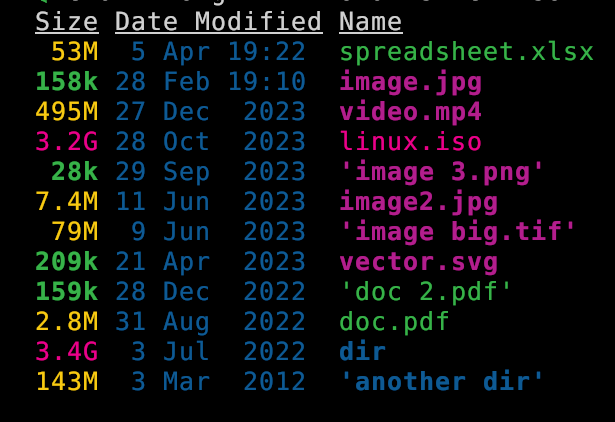cross-posted from: https://discuss.tchncs.de/post/13814482
I just noticed that
ezacan now display total disk space used by directories!I think this is pretty cool. I wanted it for a long time.
There are other ways to get the information of course. But having it integrated with all the other options for listing directories is fab.
ezahas features like--git-awareness,--treedisplay, clickable--hyperlink, filetype--iconsand other display, permissions, dates, ownerships, and other stuff. being able to mash everything together in any arbitrary way which is useful is handy. And of course you can--sort=sizedocs:
--total-size show the size of a directory as the size of all files and directories inside (unix only)It also (optionally) color codes the information. Values measures in kb, mb, and gb are clear. Here is a screenshot to show that:
eza --long -h --total-size --sort=oldest --no-permissions --no-user
Of course it take a little while to load large directories so you will not want to use by default.
Looks like it was first implemented Oct 2023 with some fixes since then. (Changelog). PR #533 - feat: added recursive directory parser with `–total-size` flag by Xemptuous



It’s written in a safe language
there’s no such thing as safe language. People sent spaceships to moon with assembly. But there is one such thing as undereducated bootcamp grad developer.
We have tried the “sufficiently experienced and disciplined developer” approach for decades and it just doesn’t work.
You’re both right!
Not sure that really applies here since ls is usually a shell built-in so you can’t exactly uninstall it, not to mention all this feature creep probably means exa/eza has a much larger attack surface.
Does it use safe development practices though? Or is mainstream Rust development npm leftpad all over again with developers dumpster diving for dependencies to make their lives easier and more productive.
There is potentially a price to pay for colour ansi graphics and emoji and it comes in the form of a large tree of often trivial third party crates of unknown quality which could potentially contain harmful code. Is it all audited? Do I want it on a company server with customer data or even on a desktop with my own data?
The various gnu and bsd core utils are maintained by their projects and are self contained without external dependencies and have history. There are projects rewriting unix core utils in Rust (uutils) that seem to be less frivolous which are more to my taste. Most traditional unix utils have very limited functionality and have been extensively analyzed over many years by both people and tools which offsets a lot of the deficiencies of the implementation language.
I am inclined to agree with you. See my comment in cross post of this thread.
I’m just a home admin of my own local systems and while I try to avoid doing stuff that’s too wacky, in the context I don’t mind playing a bit fast n loose. If I screw it up, the consequences are my own.
At work, I am an end user of systems with much higher grade of importance to lots of people. I would not be impressed to learn there was a bunch of novel bleeding edge stuff running on those systems. Administering them has a higher burden of care and responsibility and I expect the people in charge to apply more scrutiny. If it’s screwed up, the consequences are on a lot of people with no agency over the situation.
Just like other things done at small vs large scale. Most people with long hair don’t wear a hairnet when cooking at home, although it is a requirement in some industrial food prep situations. Most home fridges don’t have strict rules about how to store different kinds of foods to avoid cross contamination, nor do they have a thermometer which is checked regularly and logged to show the food is being stored appropriately. Although this needs to be done in a professional context. Pressures, risks and consequences are different.
To summarize: I certainly hope sysadmins aren’t on here installing every doohicky some dumbass like me suggests on their production systems. :D